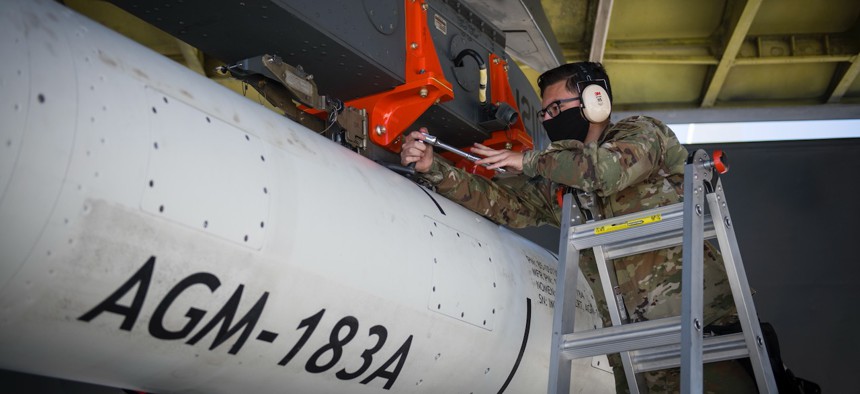
Staff Sgt. Jacob Puente secures the AGM-183A Air-launched Rapid Response Weapon Instrumented Measurement Vehicle 1 as it is loaded under the wing of a B-52H Stratofortress at Edwards Air Force Base, California, on Aug. 6, 2020. Giancarlo Casem/USAF
Another US Hypersonic Missile Hits Mach 5 in Test, Air Force Says
Three different U.S. weapons have now demonstrated successful hypersonic flight.
A Lockheed Martin-made missile flew five times the speed of sound on Saturday, the U.S. Air Force said Monday, bringing to three the number of U.S. hypersonic weapons that have achieved successful test flights.
The AGM-183A Air-launched Rapid Response Weapon, or ARRW (pronounced: arrow) found success in its unpublicized Saturday test over the Pacific Ocean after failing in three earlier test flights.
“This was a major accomplishment by the ARRW team, for the weapons enterprise, and our Air Force,” said Brig. Gen. Heath Collins, Air Force program executive officer for weapons, in an emailed statement. “The team's tenacity, expertise, and commitment were key in overcoming the past year's challenges to get us to the recent success. We are ready to build on what we've learned and continue moving hypersonics forward.”
The successful test comes amid a U.S. military effort to develop several types of hypersonic weapons to match similar Chinese and Russian advancements. Hypersonic weapons are maneuverable in flight, making them difficult to intercept. Russia has reportedly used hypersonic weapons during its ongoing invasion of Ukraine.
During Saturday’s test off the Southern California coast, the missile separated from a B-52 bomber, its “booster ignited and burned for expected duration, achieving hypersonic speeds five times greater than the speed of sound,” the Air Force said in the statement.
“Our highly-skilled team made history on this first air-launched hypersonic weapon,” Lt. Col. Michael Jungquist, commander of the 419th Flight Test Squadron, said in a statement. “We're doing everything we can to get this game-changing weapon to the warfighter as soon as possible.”
In recent months, top Pentagon officials have been pushing to speed up development of the fast-flying weapons. Former government and industry officials say old U.S. testing ranges and infrastructure are slowing development.
Last month, the Pentagon said it successfully tested a different Lockheed-made hypersonic weapon. Another hypersonic weapon, made by Raytheon Technologies and Northrop Grumman, successfully flew last year.
“This is great news for the Air Force and for the joint approach to hypersonic fires,” Thomas Karako, director of the Missile Defense Project at the Center for Strategic and International Studies, said of the successful ARRW test. “It’s going to take a cooperative effort from all the services, basing from all domains, and a mix of hypersonic, supersonic, and garden-variety subsonic strike capability of all sorts to present China with more dilemmas than they can solve.”




